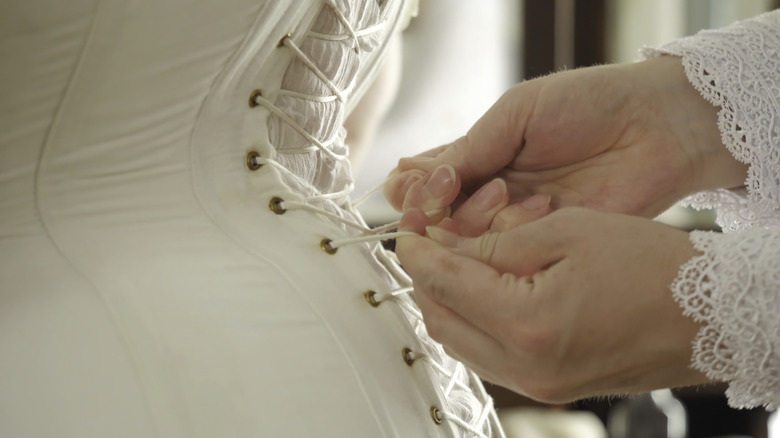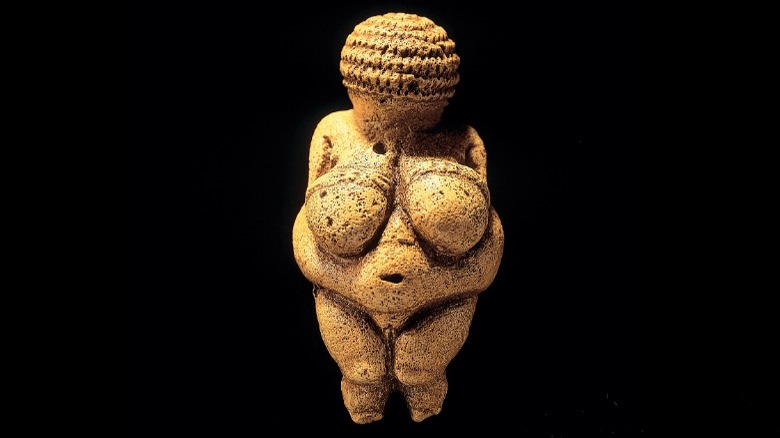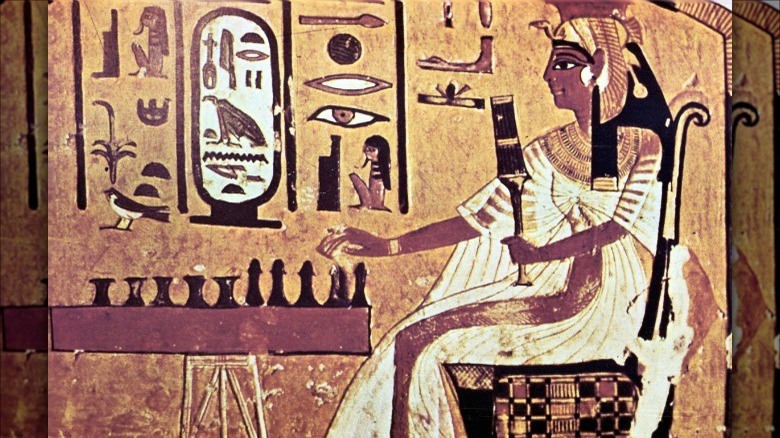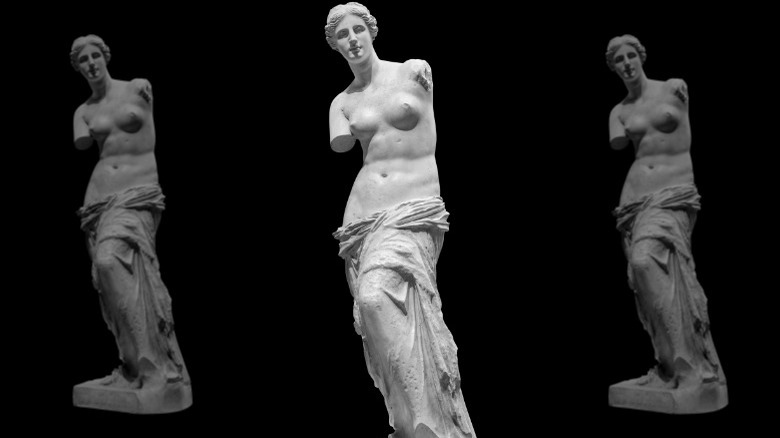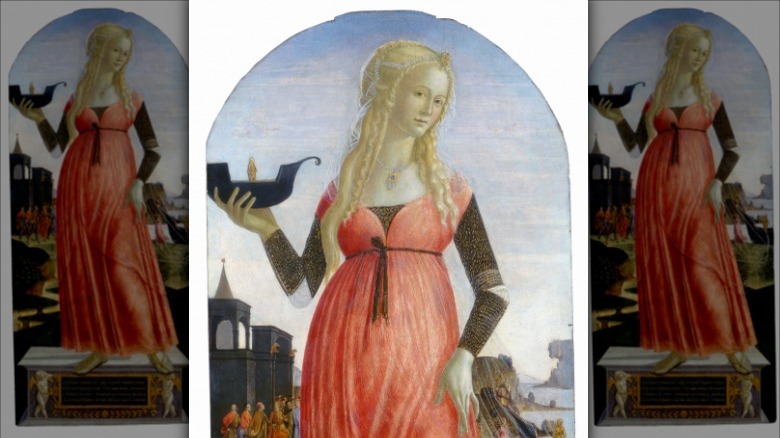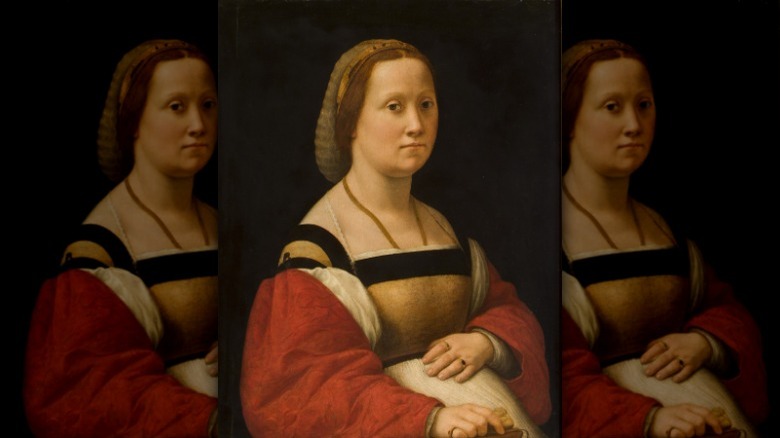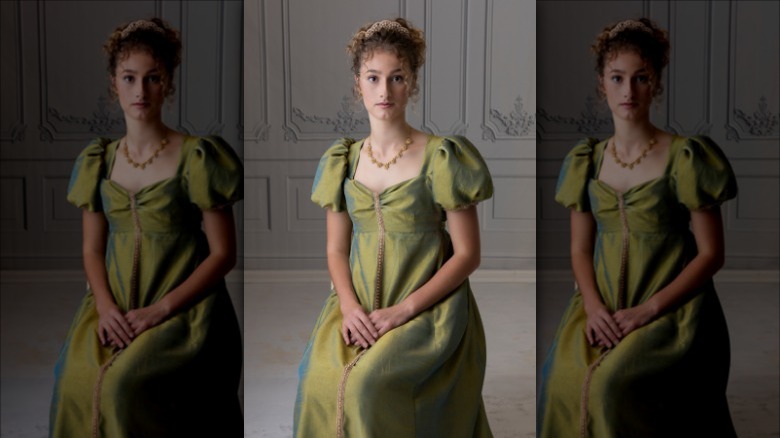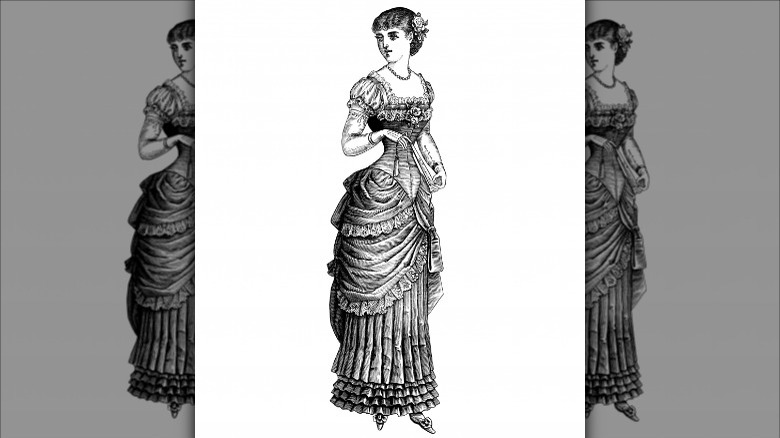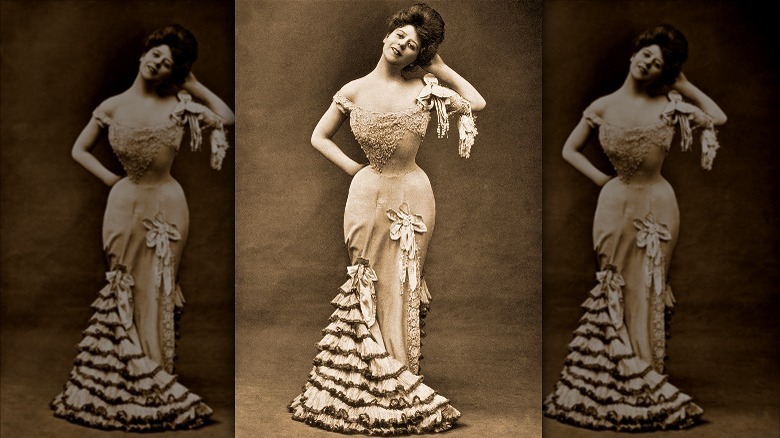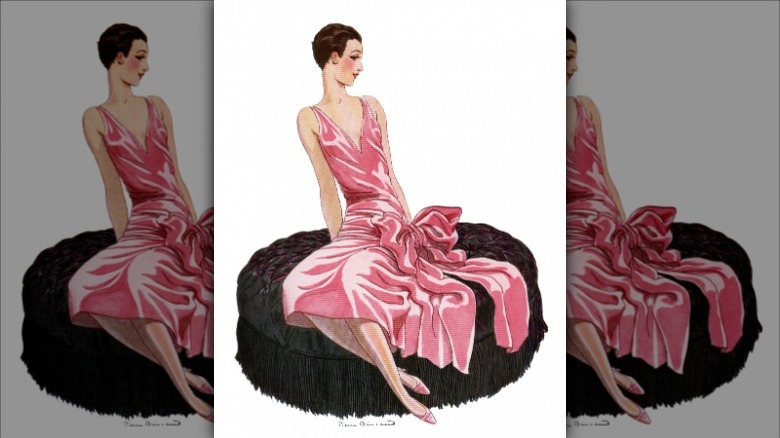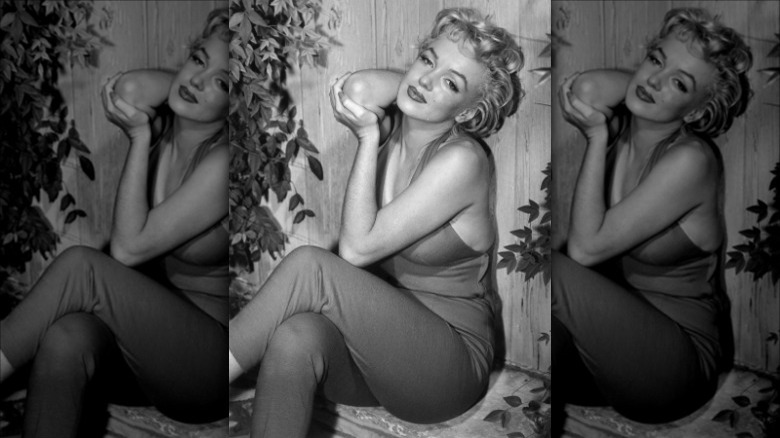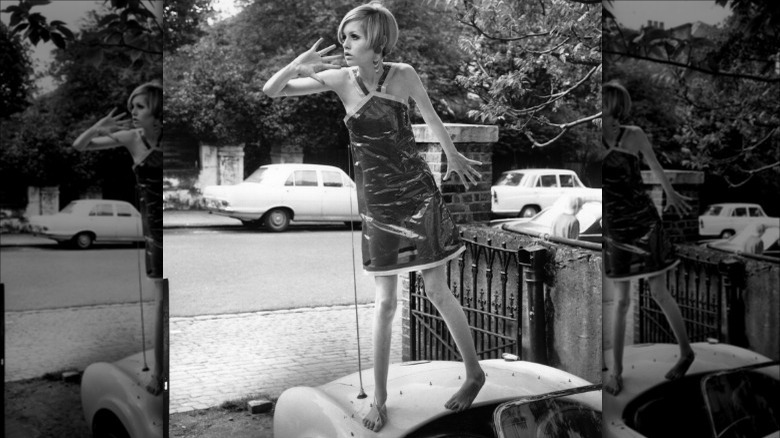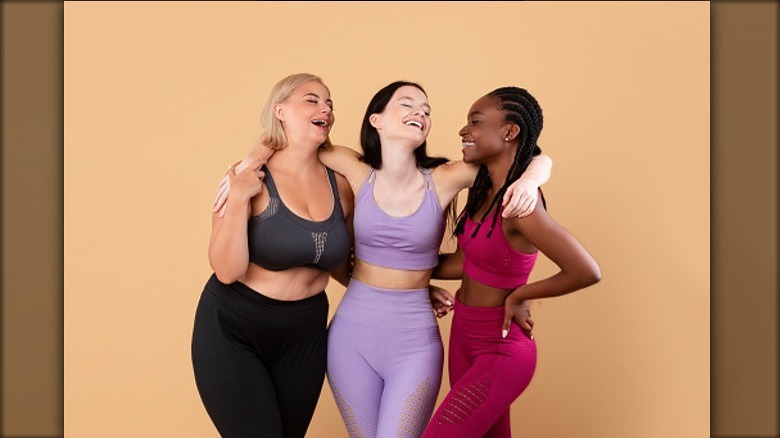The Evolution Of Women's 'Ideal' Body Types
Be it wrestling with a curling iron or attempting to put on a brave face after a long night in heels, we women put ourselves through a lot. But to make matters worse, society — since the dawn of time — has put in its two cents in regard to women as well. Not only has the societal standard of the "perfect" woman and wife existed throughout history, but the idea of what a woman's body should look like has long been a hot topic of conversation. Sometimes, it can be easy to blame our generation's obsession with image on the social media storm of the 21st century, but as it turns out, our ancestors were just as infatuated with bodies as we are today.
Back in 2017 and 2018, an exhibit at the Fashion Institute of Technology in New York featured a collection of historical findings and artifacts that represented fashion's ideal body types over time. "Whether it's contemporary or 19th century, they want to know what size it is or what size it would correlate to, or what measurement it is," Emma McClendon, the organizer of the exhibition called "The Body: Fashion and Physique," told CNN. "We as a culture, as a society, are obsessed with size. It's become connected to our identity as people."
So, whether we were running around with woolly mammoths or sculpting with Michelangelo, the world, even then, had something to say about women's perfect body types.
The full-figured Paleolithic Era
30,000 BC: The last period in history that likely comes to mind when thinking about which eras' body types defined a point in time. But believe it or not, early artifacts of this time period – which scientists believe represent the ideal body standards of the time – portray beauty as full-figured women with robust chests, rounded stomachs, and pronounced pubic areas. It is hypothesized that these emphasized female attributes were key elements in representing fertility and nourishment — two major driving factors in what was considered to be ideal for our ancestors. Plainly, it was thought that having meat on your bones to increase your odds of surviving and bearing healthy children made you sexy in the Paleolithic Era.
What's more, one of the earliest and most famous pieces of art discovered from the Paleolithic Era is the Venus of Willendorf figurine – a four-inch miniature stone carving of a corpulent woman that is estimated to be from somewhere around 24,000-22,000 BCE. What makes this finding so significant is the defined reproductive organs of the piece, including her large breasts and pubic area, and lack of emphasis on hands, feet, and facial features. Though professionals are not entirely sure what the sculpture was used for, these pronounced aspects have led archaeologists to believe that the figurine is connected to fertility and childbearing qualities — the beauty standards of the time.
The hourglass ideals of Ancient Egypt
Arguably, Ancient Egypt was one of the most fascinating periods throughout human history. Pioneers of modern art, studies, and inventions, the Ancient Egyptians also had a heavy hand in the beauty world. In fact, it is often believed that Ancient Egyptian culture was more heavily invested in and influenced by beauty than our current times — and that's saying something. Oftentimes, in ancient hieroglyphic depictions, the Egyptians were painted and drawn extremely favorably and artistically, while the faces and bodies of enemies were portrayed as almost supernaturally unrealistic and monster-like.
These artistic portrayals show us that long, braided, brunette hair and symmetrical and youthful face were important factors in feminine beauty. Typically, women were painted with slender, high waists, wider hips, and slim shoulders. Moreover, the Egyptian women utilized waxing techniques to ensure smooth, hair-free skin at all times. From there, incense and masks were used to give women's skin a yellow tint — a color that represents purity and youth, two traits that were considered attractive for women of the period.
The plump standards of the Classical Age
While the Classical period of music didn't occur until somewhere roughly around 1730 AD, the Classical Age in history is actually a different time frame entirely. Called the Classical Age or Classical Period, 500 to 336 BC was a powerful time for ancient Greece. After obtaining a triumphant victory over Persia, Greece began to take on a whole new outlook on philosophy, art, theater, and architecture; thus, the ancient Greece we most commonly think of today was born. Greek mythology was at its height during this period, meaning that how the gods and goddesses were depicted had an enormous role to play in the beauty standards of the time.
For women, even though male beauty was seen as the ideal, there were still some rules to follow. If a woman was curvy and larger, it signified that she had the means to eat plentifully and was not stricken with poverty or hunger, as social status was considered an elite virtue. Aphrodite, the goddess of love, beauty, and fertility, was considered to be the ultimate form of feminine beauty, so women of ancient Greece looked up to her as the standard. Aphrodite was described as having "desirable breasts," soft, pear-shaped curves, and long, flowing hair.
The confusion of the Middle Ages
The Middle Ages was a harsh and confusing time for women, to say the least. The rise in Christianity governed basically, well, everything, and most women were either considered to be inferior to men or witches associated with evil. This makes it a bit difficult to come to a conclusion on one specific ideal body type of this period, however, what we can derive from artworks of the time is that most women were depicted with a small, delicate upper body, but a slightly protruding and rounded lower abdomen. This is perhaps due to the fact that it was believed that eating food made one closer to God, so those with larger midsections were said to be more Godly.
On the other hand, the larger stomach ideal may have also had to do with fertility. "Rather than celebrate the physical form like the Greeks and Romans, early Christians saw the body as weak and prone to sin," Dr. Amelia Serafine of the History Department of San Antonio College in Texas explains to Pure Gym. "The medieval body was also prone to illness, including the Black Death. What was the ideal body in the Dark Ages then? Probably a body without signs of the plague! In the 15th century, French and Burgundian women wore a stuffed sack under clothing to look pregnant. In sparsely populated post-plague Europe, fertility was fashionable."
The rounded look of the Renaissance
Once the world began to come out of the Dark Ages, a new sense of liberation began to take flight. Art was once again focused on the beauty of the naked human body, and women were seen as having a moral duty to appear beautiful to society. In fact, physicians were often always on hand during the Renaissance to offer women beauty treatments advice. If your eyes weren't dark brown, dye would be placed into the irises to present a more desirable color, while leeches were adhered to the face to drain the blood for a more pale, whitened look.
Aside from facial beauty, the form of the female body was of great importance as well. Being thin was considered a problem during the Renaissance, so specific foods were eaten to keep the arms and legs plump and fleshy, the hips wide, and the stomach round. What's more, famous Renaissance artist Raphael, who most notably depicted curvaceous female subjects, stated that his paintings were not based on real human studies, but rather on what he believed to be the ideal standard of beauty.
The petite nature of the Regency Era
If your past few years haven't constituted lengthy binge-watch sessions of the steamy Netflix romance "Bridgerton," allow us to fill you in a bit on the period in history known as the Regency Era. The era itself was the dawning of a newer, much more sophisticated air than England had previously known, which might be exactly why so many fictitious romances take place during this time period. Although it only lasted a decade, Regency was an era of strict hierarchies (making for a fabulous forbidden love story), immaculate and intricate gowns, and female voices like Jane Austen shaping feminism in a way the world had never seen before.
As noted in a snippet from "La Belle Assemblée," a fashion book from 1806, slender and tall female bodies were en vogue in order to support the style of dresses popular at the time: low, square-cut necklines with puffed sleeves, high-waisted bodices, and soft muslin that gathered and clung to the body as the fabric fell to floor-length. Yet, although the body type was more slender and less plump than eras like the Renaissance preferred, paintings from the Regency Period depict women with fuller buttocks and dimpling thighs — signs that society still had an eye on the correlation between wealth and food.
The cinched waists of the Victorian Era
Throughout the majority of the most prominent times in history, being curvy and voluptuous was an ideal and coveted trait; however, when the 19th century hit, things began to take a major shift. Within parts of Europe and North America, women started embracing what was called the "steel engraving lady." The principle behind this ideal was that women desired to appear frail, dainty, and subservient — all in part of playing the role of the inferior counterpart to male suitors. As a matter of fact, some women went so far as to ingest a bit of arsenic to appear more pale and delicate.
"For women, the 19th century demanded a small waist, rounded shoulders, high breasts, and absurdly small hands and feet," Dr. Serafine tells Pure Gym. "Very few women met these standards," she continues, "so they resorted to dresses with huge starched sleeves and corsets — complete with padded breasts and false buttocks to create an exaggerated and impossible hourglass figure." In summary, the more petite and delicate you appeared, the more attractive you were.
The long and lean vision of the Industrialization era
As the 20th century approached, women's perfect body types changed continuously — thanks to the popularity of growing artists like Picasso and Matisse. "Then, in the 20th century, there's a very defined shift towards an increasingly young and increasingly kind of athletic and slender body," Emma McClendon told CNN. Although it has never been pinpointed what exactly caused the major shift between the voluptuous ideals of most of human history and the ideals of the 20th century, the slender body type has remained an image of perfection ever since.
Aside from this, the "Gibson Girl," who emerged in the mid-1890s, was still very en vogue up until the 1920s. Charles Dana Gibson, an illustrator from North America, drew what he described as the perfect and ideal American woman, which became society's standard of what a beautiful and modernly independent woman should look like: Gibson Girls were portrayed with soft, bedroom eyes, full lips, prominent-but-petite curves, and voluminous, feminine curls. The Gibson Girl became one of America's first major marketing tools in the beauty world, and businesses quickly learned just how much control over women's ideals they had with media.
The androgynous appearances during roaring 1920s
As most of us are aware, the 1920s was the true "flapper girl" era. This was a decade seemingly willing to toss the Gibson Girl look right out the window; 1920s women were all about shedding clothing while bending rules and acting silly, immature, and reckless. With this came the idea that feminine ideals were to be rejected, and in turn, more androgynous and genderless looks became the norm. Small breasts, an A-line figure, and short haircuts were all the rage.
Unfortunately, along with the bras that were designed to minimize the bust and dresses that were created to make legs appear slimmer and longer, the 1920s were the first era in history that glamourized eating disorders. In fact, the bust-to-waist ratio of models in the '20s dropped a whopping 60% in comparison to models of the early 1900s, and as the "Journal of Communication" reported in 1997, "The highest reported prevalence of disordered eating occurred during the 1920s and 1980s, the two periods during which the 'ideal woman' was thinnest in US history" (via CNN).
The curves of 1930 to the 1950s
During the 1930s all the way up until the 1950s, Old Hollywood ruled the world. Movies were becoming more technically and stylistically advanced, which meant a brief escape from the darker realities of the Great Depression and World War II. Actresses on the silver screen were the biggest influences on body image and fashion, so starlets like Marilyn Monroe brought back a curvier look in stark contrast to the bodies of the '20s. However, during the '30s when the depression occurred, body type and clothing seemed rather trivial to the average woman, so a more natural look of being neither extremely thin nor unrealistically curvy was commonly seen.
During World War II, women were trained to basically "upcycle" the unused military suits of men who were off fighting in the war, so everyday women's clothes consisted of tailored suit jackets and skirts that showed off their legs, which, in turn, emphasized a curvy hourglass figure. Still, average women (celebrities aside) were smaller in contrast to women of today's times, with an average BMI of 23.6 compared to today's average of 26.5.
The supermodel looks of the '60s to the '90s
The dawning of the 1960s brought a lot of good (and bad) with it, but one of the most influential cultural shifts was the sexual revolution. Much like in the 1920s, women were experiencing a sense of liberation and freedom which paved the way for an extremely thin, androgynous look to come back around full circle. And who was at the forefront of this idealization? You guessed it, none other than one of fashion's first international supermodels — Twiggy. When Twiggy stepped inside House of Leonard — a high-end London hair salon — to buy shampoo one day, the owner asked if he could cut her hair. The result was the iconic platinum blonde pixie cut we all know and love today, and after being photographed to promote the salon, the rest was history.
Although the end of the '60s was met with the "hippie era," which allowed women to embrace a soft silhouette once again, Twiggy's slender and thin physique continued to dominate fashion and the look of supermodels all the way up into the '90s. And what happens when something is big in fashion? The world surely wants to follow suit.
The 2000s to the 2020s
Depending on your age, most of us can probably recall what growing up in the 2000s was like as far as body image. Regrettably, due to our parents being raised in a time when Twiggy and supermodel fashion was at their height, many of us felt the effects of what having an "almond mom" was like. But as we aged, a large number of us had to ask ourselves if we simply had concerned parents or if they were projecting their own desires for perfection onto us.
Thanks to the reign of the Kardashian and Jenner crew since the early 2010s — whether we like to admit it or not — most modern American women tend to strive for a curvy figure with a slim waist, thick thighs, and a rounded, lifted backside. Influencers have followed suit, and the BBL (Brazilian butt lift) surgery is more common than ever, with increases of as much as 37% in BBLs performed in 2021 over 2020.
On the upside, for the first time in history, more and more women are beginning to embrace their bodies and love them for exactly what they are. There are always going to be certain ideals and people who think women should look a certain way, but the closer we come to finding the beauty in what comes naturally to us, the closer we are to someday seeing a world where everyone's unique form is the only ideal we will be striving for.
